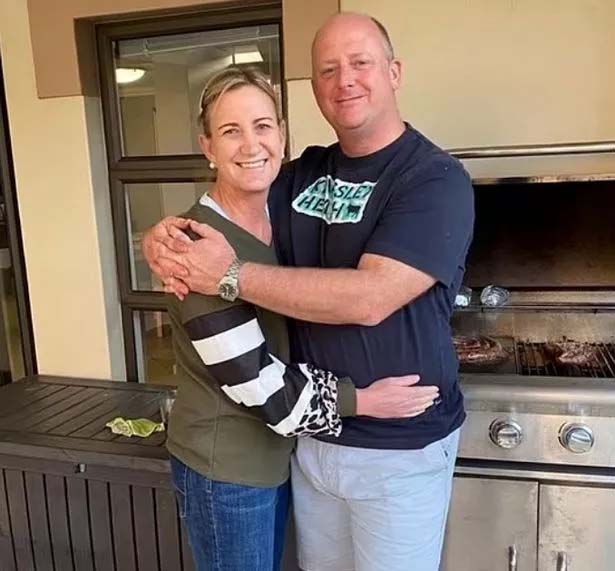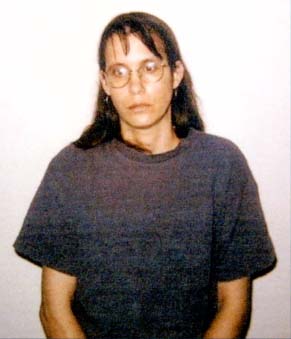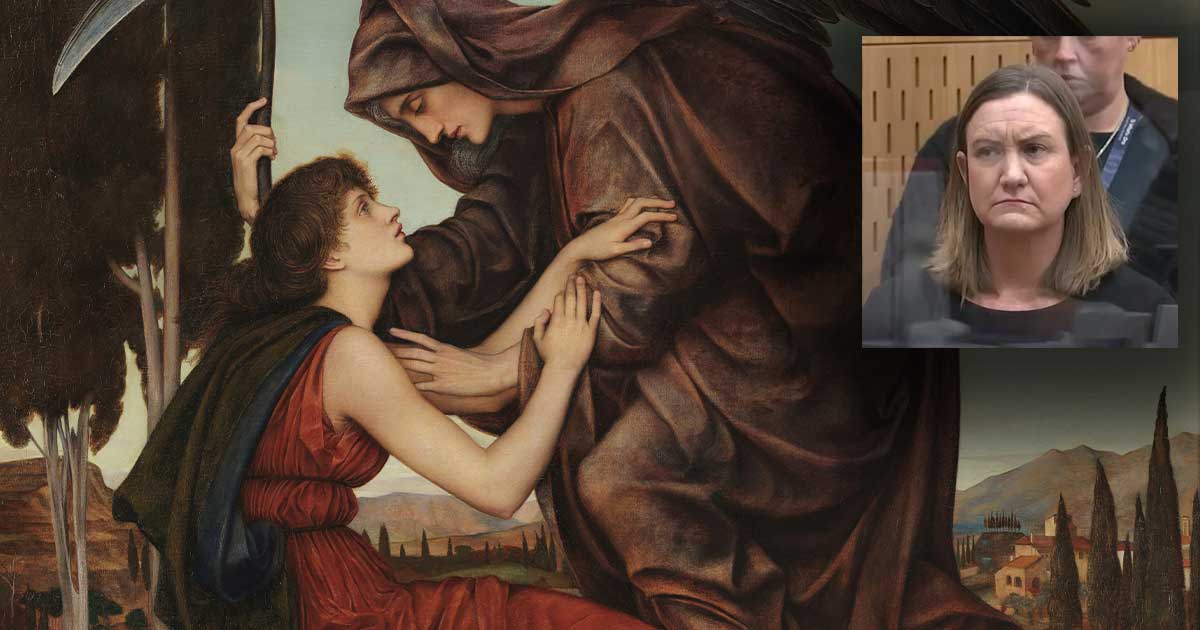There is a common misconception that Angels of Death and Angels of Mercy refer to the same typology of serial killers and the terms are used interalia, since they have similar victim profiles, and are often in the medical profession, yet they differ in their motivation.
Angels of Death generally operate in a hospital, clinic or nursing home, where the murders may be disguised as medical fatalities and they have the medical knowledge to choose weapons or cause of death to facilitate this. They also have easy access to life-sustaining equipment. Regarding their motivation, they enjoy the power they have over life and death and might sometimes also benefit from life insurance policies they convinced their geriatric patients to cede to them.
Angels of Mercy are serial killers, usually women, who are under the illusion that their children will be better off dead, that they do not want their children growing up in a hostile world, or that their children would not be able to cope without their biological mothers, therefor by killing them, they commit and act of mercy. These women are often afflicted by postpartum depression, major depression and anxiety disorders and some may suffer from delusional disorders. Angels of Mercy are also more likely to commit or attempt suicide after the event.
Then there are also those who by Münchhauzen by Proxy kill their children for their own psychological gain of getting attention. Münchhauzen by Proxy is a psychological term for when a person purposefully exaggerates, invents or induces an illness in someone else to get attention. These people, mostly women may manifest characteristics of personality disorders.
The Angels of Death, Angels of Mercy and Münchhauzen by Proxy often enter an insanity plea.
Dr Lauren Dickason
A case study of an Angel of Mercy – or not – is South African Dr Lauren Dickason who, scarcely after a few weeks of immigrating from Pretoria to Timaru in New Zeeland, was charged with murdering her twin girls, Maya and Karla, aged 2, and their 6-year-old sister Liane, in September 2021.

Lauren Dickason was diagnosed with depression and anxiety at the age of 15. She qualified as a medical doctor in 2004 and married Graham Dickason, an orthopaedic surgeon in 2006. The couple struggled to fall pregnant and Lauren had 17 rounds of IVF. In 2013 she was pregnant with their first child, who was born after 18 weeks of pregnancy, called Sarah. Sadly Sarah passed away and a year later in 2014 their second daughter, Liane was born. In 2015, Lauren was diagnosed with a major depression order with underlying anxiety, linked to postpartum depression after the death of Sarah. Three years later in 2018, the twins Karla and Maya were born.
Despite happy family photos posted on Facebook, it emerged that Lauren had trouble falling asleep, she had suicidal ideation, panic attacks and intrusive thoughts, all due to the loss of Sarah. When Karla was born with a cleft palate, it did not help matters. A year after the birth of the twins, Lauren consulted a psychiatrist and admitted to having intrusive homicidal thoughts towards her children. Her husband Graham had in the meantime secured a position as an orthopaedic surgeon in New Zeeland and the couple made plans to immigrate in August 2020, but their migration plans were delayed by the global COVID-19 pandemic and immigration issues.
Lauren’s mental health improved between late 2020 and June 2021 to such an extent that she decided to quit her antidepressants by March 2021 – this is inadvisable without consulting a doctor, but she was a doctor herself. In June 2021 conditions in South Africa deteriorated due to riots and looting instigated by the arrest of former president Jacob Zuma. Due to Covid and the country being on fire, she isolated herself and the children. Her homicidal ideation towards her children increased to such an extent that she informed Graham. He instructed her to resume her medication, which she did in August 2021. Lauren’s homicidal thoughts continued following a foot surgery. Lauren began researching methods to overdose her children on the Internet, and then erased the search history.
In August 2021, two weeks before their immigration date, Lauren observed her husband and daughters playing with cable ties. After two weeks of managed isolation as part of the immigration process, the family finally arrived in Timaru on 11 September 2021. Five days later, Lauren killed her daughters.
From the beginning Lauren was unhappy with the move. She found the accommodation “disgusting and creepy”, and imagined her children becoming victims of cyberbullying and compared the circumstances of indigenous Māori people to Apartheid in South Africa. Lauren sincerely regretted emigrating to New Zealand. Mobile text messages to her friends in South Africa reflect Lauren’s disillusionment and ‘jokes’ about killing the twins and how naughty they were.
On the 16 September 2021, Liane attended her second day at Timaru primary school and the twins their very first day at the preschool. For the first time in many months, Lauren had a day all to herself. When she picked the children up from school, Karla threw a tantrum in the car. The family visited the botanical gardens in the afternoon – a very normal day any mother would recognize. However Lauren was not a normal mother. She noticed a boy taking photographs of her daughters and feared for their safety, likening the situation to dangerous South Africa. Lauren admitted to having thoughts of “brutally killing” the children by means of sedating them and cutting their femoral arteries.
That evening her husband Graham went out with colleagues, leaving Lauren alone with her children. After gathering the children in a bedroom, she told them they were going to make necklaces with cable ties. She told her children “Mummy’s very sick and is going to die. I can’t leave you behind because I don’t know who’s going to look after you.” Lauren then pulled the cable ties around each daughter’s neck, starting with Kayla and then Liané and lastly Maya. Liané had fought back and “wanted to know why I’m doing this to them because I’m the best mum and she loves me.” As they were still breathing, she smothered them with pillows and then placed them in their beds and tucked them in. Lauren searched the house for a sharp knife, but they were all blunt, so she took some pills in a suicide attempt.
Just before 10 pm Graham returned home to find the bodies of his children in their beds. Distraught he called the neighbours who alerted the police. They took Lauren into custody and the following day, after she had been medically cleared, they interviewed her. She admitted to killing the children and the reason for killing Karla first: “I did the twins first… The first one was being really, really, really horrible to me lately. She has been biting me and hitting me and scratching me and throwing tantrums 24 hours a day – and I just don’t know how to manage that. That is why I did her first.” She was admitted to a psychiatric hospital.
At Hillmorton Hospital, she was interviewed by five forensic psychiatrists and psychologists for a total of 53 hours. Three of them, Dr Susan Hatters-Friedman, Dr Justin Barry-Walsh and Dr Ghazi Metoui, believed she was severely mentally unwell and could claim a defence based on insanity or infanticide. Under New Zealand law, infanticide can be used as a partial defence to murder or manslaughter. The two doctors, Erik Monasterio and Simone McLeavey believed that Lauren killed her children out of anger and control, including not wanting to let another woman parent her children if she either died and Graham remarried.
Lauren Dickason’s trial commenced on 17 July 2023 at the Christchurch High Court with Judge Cameron Mander presiding. Andrew McRae served as Crown prosecutor. Her defence team was Kerryn Beaton QC and Anne Toohey, who argued that Lauren’s decision to kill her children was “spontaneous” because Lauren believed that her and the children’s lives were not worth living and “that they were all better off dead”. Thus she would present as an Angel of Mercy killer. Anne Toohey also presented postpartum depression as a mitigating factor.
Graham had returned to South Africa after the trauma. On the second day of the trial he testified via an audio link. In an important disclosure he testified he had found three sets of cable ties linked to each other in their home in South Africa. This could point to premeditation. Lauren’s mother Wendy Fawkes testified that Lauren loved her children, describing her as “overprotective, even neurotic…and very safety focussed.
Expert Testimony:
Was Lauren Dickason an Angel of Mercy or not? Our focus is on the findings of the forensic experts’ testimony.
Dr Susan Hatters-Friedman testified that Lauren frequently had homicidal ideation about killing her children. She was of the opinion that Lauren had killed her children out of love and based on her inability to parent – “the worst wife and mother”. In other words Lauren would qualify as an Angel of Mercy.
Dr Ghazi Metoui, testified that the deaths of her children were motivated by “insanity” and “infanticide” rather than murder. Dr Metoui confirmed that Lauren admitted to experiencing her first violent ideation towards her children in May 2019 when her twin daughters were six months old. Dr Metoui, described Laura as a “mother in deep despair who thought killing her daughters was the kindest thing to do.” So she was an Angel of Mercy.
Dr Justin Barry-Walsh testified that Lauren told him she experienced the killing of her children as an “out of body experience” which freed her from her troubles. Three months after the murders she struggled with guilt feelings. She reported missing her children but sometimes felt “she has saved the children from the pain of the world”. So she could be an Angel of Mercy.
Dr Eric Monasterio testified that Lauren admitted to him she made sacrifices to ensure that Graham could go hunting and work, which increased her frustrations with her children. Dr Monasterio was of the opinion that Lauren had killed her children out of anger rather than insanity or postpartum depression. So she was not an Angel of Mercy.
Dr Simone McLeavey testified that Lauren was not experiencing psychosis during the killings, and that she was suffering from depression and grievances instead. So, she was not an Angel of Mercy.
On 1 August 2023, prosecutor Andrew McRae described the case as “incredibly tragic”, and said the Crown did not dispute that Lauren was suffering from a major depressive episode when she killed her children. However, McRae argued Lauren knew that what she was doing was morally wrong, there was no altruistic motive, and that the key drivers of the killing were “anger and control”.
On 16 August 2023, in an 11-1 vote, the majority of jurors rejected Lauren’s partial defence of infanticide and defence of insanity, and accepted the Crown’s argument that she had “acted methodically, purposefully and even clinically out of anger and control” when she killed her three children. Dr Lauren Dickason had no mercy for her three daughters and was not an Angel of Mercy. The court found she did not kill her children to save them from a bad life, but rather that she killed her children because she thought her life would be better without them, as she expressed in her messages to her friend.
She was sentenced on 26 June 2024 to 18 years in prison, as three concurrent sentences. She was not given a minimum term of imprisonment, and will be kept in a mental health hospital until she is deemed mentally fit for prison. Lauren will be eligible to be considered for parole in September 2027. She has been served with a deportation notice upon serving her sentence.
By December 2024 Dr Graham Dickason had found a new love in South Africa.
Andrea Yates

Two decades before Lauren Dickason killed her three daughters in 2001, American Andrea Yates, wife of a NASA engineer Rusty Yates, at the Johnson Space Centre in Houston, Texas, drowned her five children; 7-year-old Noah, 5-year-old John, 3-year-old Paul, 2-year-old Luke, and their 6-month-old sister Mary — one by one in a bath. Then she called the police and her husband.
Like Lauren, Andrea had homicidal ideation towards her children for two years. She also suffered from postpartum depression after a miscarriage in 1993. Unlike Lauren, she believed she was marked by Satan and she saved her children from eternal damnation. This could qualify as a postpartum psychosis.
On March 15, 2002, Andrea was sentenced to life in prison, but three years later in January 2005, a Texas appeals court reversed her conviction and granted Andrea a new trial. In July 2006, Andrea was found not guilty by reason of insanity. She was transferred from prison to a mental hospital in Texas where she remains.
Dr Manuela Costa
Dr Lauren Dickason was not the first South African doctor who killed her children. Dr Manuella Costa was married to Dr Jose Gill, a prominent psychiatrist from Johannesburg, who committed suicide. Manuela had a mastectomy on both breasts due to cancer and was suffering from financial problems by 1998. She was diagnosed with major depression.
One night, in a delirious stupor, Manuela fed her children sedatives and then set their luxury home in Morningside, Johannesburg on fire. By the time the emergency services had arrived, it was too late for two of her sons, 11-year-old Michael and 9-year-old Andre. Manuela and two remaining sons survived the ordeal. Manuela suffered severe burn wounds and was sent for psychiatric observation. Her two remaining sons were placed in the foster care of their uncle in Portugal.
Unlike the case of Dr Lauren Dickason, the South African court had found that Manuela was psychotic when the crime was committed and could not appreciate the wrongfulness of her act. She was acquitted. After years of therapy, she was reunited with her two sons in 2001 and she has reopened her practice.
Top image: Archangel of Death, by Evelyn De Morgan, 1881 (Public Domain), Dr Lauren Dickason in Court (Medical brief)
